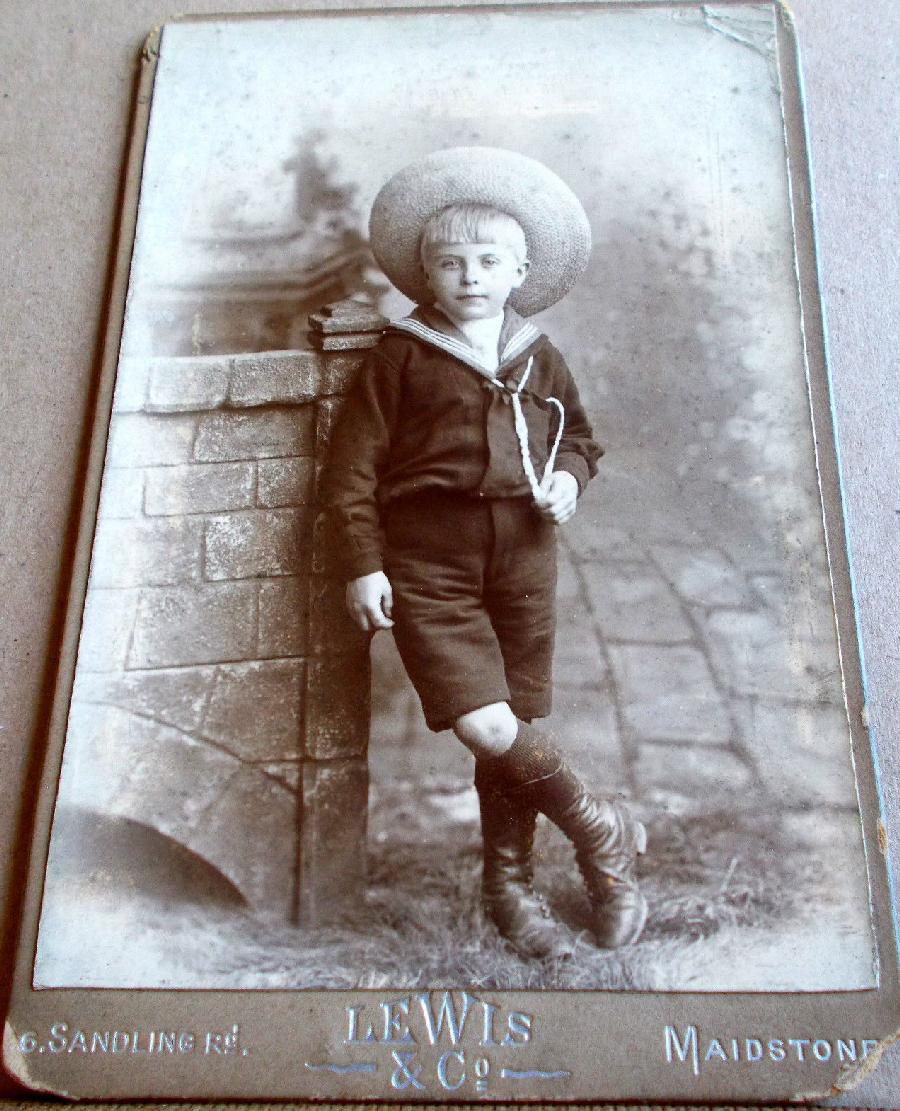
English Cabinet Cards: Mounts--Styles

Figure 1.-- This is an example of the the classic style cabinet card mounts that we see in the late-19th century. The boy is idetified as 6-year old Douglas Purdy. This portait was taken in 1895. The grey cards with silver lettering were popular around the turn-of-the 20th century. At the same time new style cards were beginning to appear.
|
|
Mounts can be very helpful in dating cabinet cards. The mounts we see in Britain including the studio information at the bottom of the card were very similar to American cabinet cards. This is important because we have worked out more information on American cabinet cards than British cards. We wonder if some of the same companies producing mount stock may have been involved. We note considerable similarities with American portraits as the mount styles and studio posing and background settings are virtually identical. Cabinet card mounts were very similar in the 19th century (1860s-90s). Without the studio information at the bottom, it would be difficult to differentiate American and English cabinet cards. Even the lettering is similar. This was often not the case for CDVs. Because of our limited English archive, however, we are still working out the details. While there were many similarities, there were also differences. We see mount style changing at the turn-of-the 20th century. Some of the classis mounts can still be found from the early 1900s, but the new style mounts mostly date from the 20th century. This also occurred in America and at the same time. At this time we more differences between English and American cabinet cards. We notice differences in sizes and decoration. We do not, for example, see American cabinet cards like the one on the previous page. As some of the new styles do not have the studio information, identifying the countries of origin can be difficult.
Classic Mounts (1860s-1905)
The mounts we see in Britain including the studio information at the bottom of the card were very similar to American cabinet cards. We see cards with images covering most of tghe area of the mount with studio information, studio and city at the bottom. American mounts include the state while Englidsh mounts do not show the county. The Maidstone cabinet card here is a good example (figure 1). This is important because we have worked out more information on American cabinet cards than British cards. We wonder if some of the same companies producing mount stock may have been involved. We note considerable similarities with American portraits as the mount styles and studio posing and background settings are very similar and in some cases virtually identical. Cabinet card mounts were very similar in the 19th century (1860s-90s). While the color and lettering varied, the size was also universal. As in America the size was 108 by 165 mm (?4 1/4 by ?6 1/2 inches). There were larger mounts, but this size was true for the vast majioruity if the cabinet cards made. This was the case because many people bought albumns with slots made for this standard size. Without the studio information at the bottom, it would be difficult to differentiate American and English cabinet cards. Even the lettering is similar. This was often not the case for CDVs. Because of our limited English archive, however, we are still working out the details. While there were many similarities, there were also differences. We see mount style changing at the turn-of-the 20th century.
Some of the classis mounts can still be found from the early-1900s, but the new style mounts mostly date from the mid-1890s and early-20th century. We see some in the late-1890s. The break seems a little earlier than in America
Mostly we see the bnew style mounts after the turn of the century in the 1900s and 10s. The new style mounts vary in size, shape, and color. Larger cards seem more common, but curioudsly not necesarily larger image sizes. Some of the cards has larger cards but relatively small images, meaning that the image covered much less of the total area of the card. This seems to have been most common in the 1900s. We are not sure why anyone would prefer this as opposed to a lsarger image, but it was popular for a time. There were different mount colors, but the same grey-green color we see in America was also popular in England. And we see highly decorative mounts. We do not know why the more varied new style mounts suddenly became populr. Unlike the classic mounts there were many different shapes and sizes. These new style mounts also appeared in America and at the same time. At this time we more differences between English and American cabinet cards. We notice differences in sizes and decoration. We do not, for example, see American cabinet cards like the one on the previous page. The highly decorative mounts are characterestically English. As some of the new styles we often do not have the studio information, identifying the countries of origin can be difficult.
HBC

Navigate the Boys' Historical Clothing Web Site:
[Return to the Main English cabinet card mount page]
[Return to the Main English cabinet cards page]
[Return to the Main English negative-based albumen process page]
[Return to the Main English negative-based photography page]
[Return to the Main English photography page]
[Return to the Main English page]
[Return to the Main country photography page]
[Introduction]
[Activities]
[Biographies]
[Chronology]
[Clothing styles]
[Countries]
[Essays]
[Bibliographies]
[Contributions]
[FAQs]
[Glossary]
[Images]
[Links]
[Registration]
[Tools]
[Boys' Clothing Home]
Created: 8:10 PM 4/21/2015
Last updated: 3:06 AM 3/24/2019



